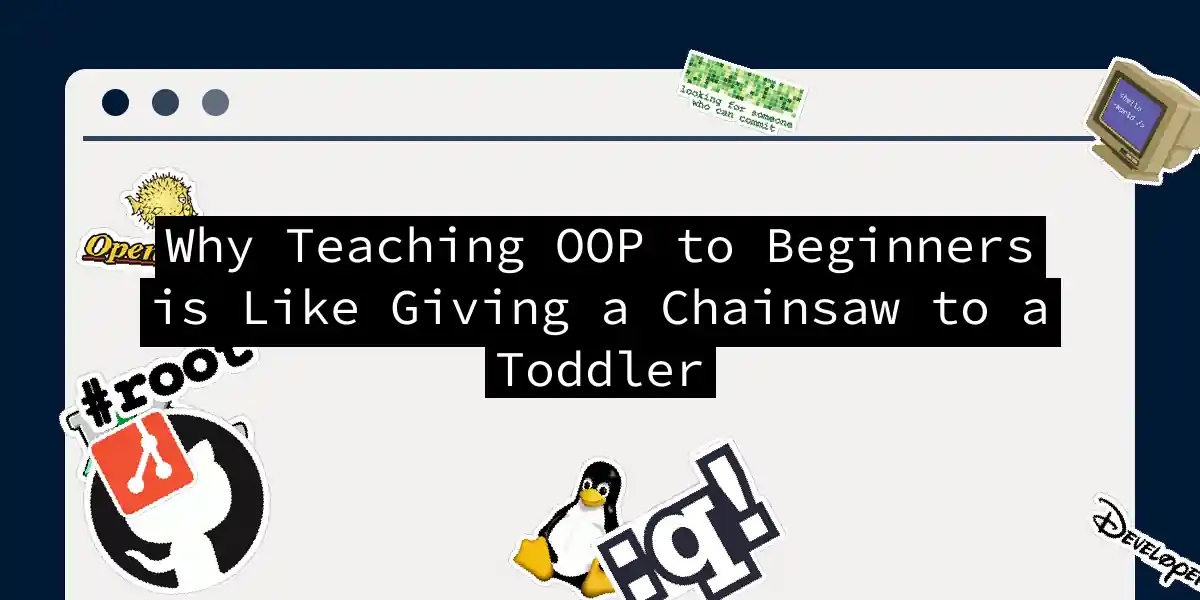Picture this: You’re trying to teach someone to make scrambled eggs. Instead of starting with a frying pan, you hand them a molecular gastronomy kit with sixteen types of emulsifiers and a sous-vide machine. That’s exactly what we’re doing when we throw object-oriented programming at coding newbies. Let’s dissect this educational travesty with the urgency it deserves.
The OOP Onion: Too Many Layers for Day One
When I first encountered OOP, I spent three days trying to understand why my Cat class kept inheriting from Animal but refused to eat the Food interface. Meanwhile, my simple temperature converter script had metastasized into 300 lines of abstraction spaghetti.
# What we force beginners to write
class TemperatureConverter:
def __init__(self, temp):
self.temp = temp
def celsius_to_fahrenheit(self):
return (self.temp * 9/5) + 32
# What they actually need
def convert_temp(temp):
return (temp * 9/5) + 32
The cognitive overload is real. New programmers spend more time wrestling with class diagrams than understanding program flow. It’s like teaching architecture by starting with skyscraper engineering instead of “here’s how bricks work.”
The Complexity Tax
OOP’s boilerplate code turns simple tasks into architectural expeditions. Let’s crunch numbers:
| Task | Procedural Lines | OOP Lines | Cognitive Load |
|---|---|---|---|
| Temperature Convert | 5 | 15 | Low vs High |
| File Parser | 20 | 50+ | Moderate vs Extreme |
| Simple Game | 100 | 300+ | High vs Overwhelming |
That “enterprise-grade” User class with 12 layers of inheritance? For a beginner’s contact form? Overengineering worthy of a Java architect’s hall of fame.
The Alternative Path: Crawl Before Polymorph
Let’s try a radical approach - teach programming progressively:
- Foundations First (Weeks 1-4):
- Variables and data types
- Basic I/O operations
- Conditional logic
- Loops and functions
- Problem-Solving Bootcamp (Weeks 5-8):
- Algorithmic thinking
- Debugging techniques
- Code organization
- Basic data structures
- OOP Transition (Week 9+):
- “Hey, notice how these functions manipulate the same data?”
- “What if we bundled them together?”
- Lightbulb moment achieved Here’s how we’d transition from procedural to OOP organically:
# Stage 1: Basic function
def calculate_area(width, height):
return width * height
# Stage 2: Grouped functions
def rectangle_area(rect):
return rect['width'] * rect['height']
# Stage 3: Natural OOP progression
class Rectangle:
def __init__(self, width, height):
self.width = width
self.height = height
def area(self):
return self.width * self.height
The “But Industry Uses OOP!” Strawman
Yes, let’s prepare beginners for enterprise codebases by immediately drowning them in design patterns. That’s like teaching kids to drive in Formula 1 cars because “that’s what professionals use.” The reality: Most entry-level programming tasks don’t require intricate OOP architectures. Web scraping, data analysis, automation scripts - these are better served with procedural or functional approaches.
A Better Curriculum Blueprint
Here’s my battle-tested learning path for absolute beginners:
- Python/Ruby Basics (8 weeks)
- Core programming concepts
- Script automation projects
- Basic file operations
- Web Fundamentals (4 weeks)
- HTML/CSS
- Server requests
- DOM manipulation
- OOP Transition Workshop (2 weeks)
- Identifying abstraction points
- Refactoring procedural code
- Simple class design
- Framework Exploration (Ongoing)
- Applying OOP in real frameworks
- Design pattern integration
- Legacy code navigation
The Proof is in the Pointer
When I taught my neighbor’s 14-year-old to code, we spent the first month making text-based games and TikTok API bots. The moment she naturally said “Maybe we should make a class for this?” marked the perfect OOP introduction point - three months in, with actual coding scars to show for it. Let’s stop pretending OOP is the only path to programming enlightenment. The next generation of coders doesn’t need inheritance hierarchies - they need to understand how to make the damn computer do what they want. After that, the object-oriented pumpkin spice latte can come when they’re ready to appreciate it. Agree? Think I’m full of semicolons? Let’s start a flame war in the comments. First round of virtual coffee’s on me.
